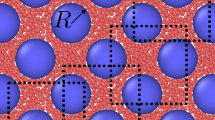Abstract
A computer algorithm for the displacement of one fluid by another in three-dimensional pore-throat network models of porous media allows the determination of fluid characteristics and distributions at any point in the displacement process. The flowing fluids are found to form two closely intertwined networks with very few regions of space containing only one fluid. Further, the fraction of dead-end invader, i.e. the ratio of the fraction of nonflowing to flowing pores is essentially constant throughout a process. The dendritic character of trapped, i.e. disconnected fluid is dependent on the degree of pore-throat correlation in the network. As a result, a given pore filled with one of the fluids is likely to have at least one neighbor filled with another fluid. Our observations imply that (1) fillable pores are very likely to be filled, and (2) clusters are not compact. The latter provides a ready explanation for the ease with which so-called oil ganglia are broken up rather than moved.
Similar content being viewed by others
References
Bear, J., 1972,Dynamics of Flow in Porous Media, Elsevier, New York.
Buckley, S. E. and Leverett, M. C., 1942, Mechanism of fluid displacement in sands,Trans. AIME 146, 107–116.
Darcy, H., 1856,Les Fontaines Publiques de la Ville de Dijon, Victor Dalmont.
Chatzis, I. and Dullien, F. A. L., 1982, Mise en oeuvre de la théorie de la percolation pour modeliser le drainage des milieux poreux et la permeabilité relative au liquide non mouillant injecte,Rev. Inst. France Petrol. 37, 183–205.
Chatzis, I., Morrow, N. R., and Lim, H. T., 1983, Magnitude and detailed structure of residual oil saturation,SPE Journal, 311–326 (Apirl 1983).
Dias, M. M. and Wilkinson, D., 1986, Percolation with trapping,J. Phys A 19(5), 3131–3146.
Diaz, C. E., Chatzis, I., and Dullien, F. A. L., 1987, Simulation of capillary pressure curves during bond correlated site percolation on a simple network,Transport in Porous Media 2, 215–240.
Dullien, F. A. L., 1979,Porous Media, Academic Press, New York.
Fatt, I., 1956, The network model of porous media,Petrol. Trans. AIME 207, 114–118.
Islam, M. R. and Bentsen, R. H., 1987, Effect of different parameters on two-phase relative permeability,AOSTRA J. Res. 3, 69–90.
Jerauld, G. J. and Salter, S. J., 1990, The effect of pore-structure on hysteresis in relative permeability and capillary pressure: Pore-level modeling,Transport in Porous Media 5, 103–151.
Larson, G., Davis, H. T., and Scriven, L. E., 1981, Displacement of residual nonwetting fluid from porous media,Chem. Eng. Sci. 36, 75–85.
Larson, G., Scriven, L. E., and Davis, H. T., 1977, Percolation theory of residual phases in porous media,Nature 268, 409–413.
Lenormand, R. and Zarcone, C., 1984, Role of roughness and edges during imbibition in square capillaries,SPE 13264.
Li, Y., Laidlaw, W. G., and Wardlaw, N. C., 1986, Sensitivity of drainage and Imbibition to pore structures as revealed by computer simulation of displacement process,Adv. Coll. Interface Sci. 26, 1–68.
Maier, R. and Laidlaw, W. G., 1990a, The statistical properties of immiscible fluid displacement in bond/site correlated network models of porous media,Mathematical Geology, in press.
Maier, R. and Laidlaw, W G., 1990b, Invariants for the critical points in network models of flow in porous media,J. Stat. Phys., in press.
Muskat, M., 1949,Physical Principles of Oil Production, McGraw-Hill, New York.
Payatakes, A. C. and Dias, M. M., 1984, Immiscible microdisplacement and ganglion dynamics in porous media,Rev. Chem. Engg. 2(2), 85–174.
Spanos, T. J. T. and de la Cruz, V., 1986, The construction of reservoir scale flow equations for immiscible displacement,AOSTRA J. 214, 205–212.
Vyssotsky, V. A., Gordon, S. B., Frisch, H. L., and Hammersley, J. M., 1961, Critical percolation probabilities (bond problem),J. Chem. Phys. 53, 3759–3761.
Wardlaw, N. C. and Li, Y., 1988, Fluid topology, pore size and aspect ratio during imbibition,Transport in Porous Media 3, 17–34.
Wilkinson, D. and Willemsen, J. F., 1983, A new form of percolation theory,J. Phys. A. 16, 3365–3376.
Author information
Authors and Affiliations
Rights and permissions
About this article
Cite this article
Maier, R., Laidlaw, W.G. Fluid topology for invasion percolation in 3-D lattices. Transp Porous Med 10, 221–234 (1993). https://doi.org/10.1007/BF00616810
Received:
Revised:
Issue Date:
DOI: https://doi.org/10.1007/BF00616810




